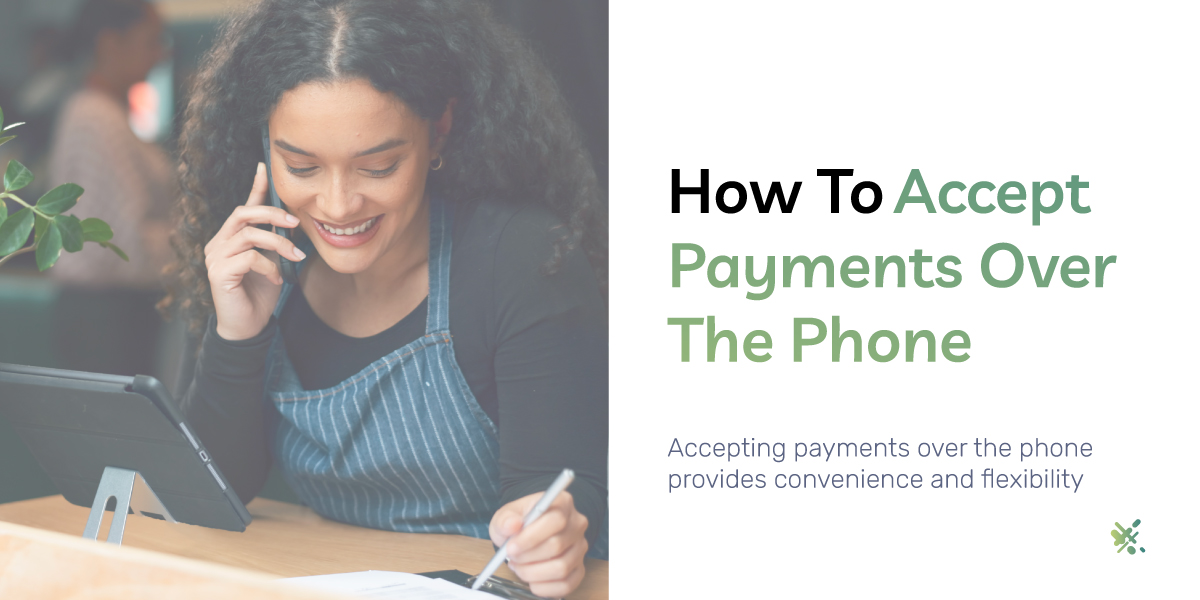Does your sales model revolve around closing deals over the phone? If so, you’ll need something different from credit card terminals. You’ll have to accept card payments verbally and input the information yourself—or will you? Let’s look at a few ways to take card payments over the phone.
What Types Of Businesses Need To Accept Payments Over The Phone?
Let’s examine why your midsize or small business needs to collect payments over the phone. Is your business a…
- Hotel?
- Restaurant?
- Service Provider?
- Pharmacy or Medical Office?
- Sales-Powered Organization?
Chances are you cannot rely on a POS system—you may not even need one—but you will need a payment processor for taking credit or debit card payments. Let’s start at the bottom of the pyramid with sales organizations.
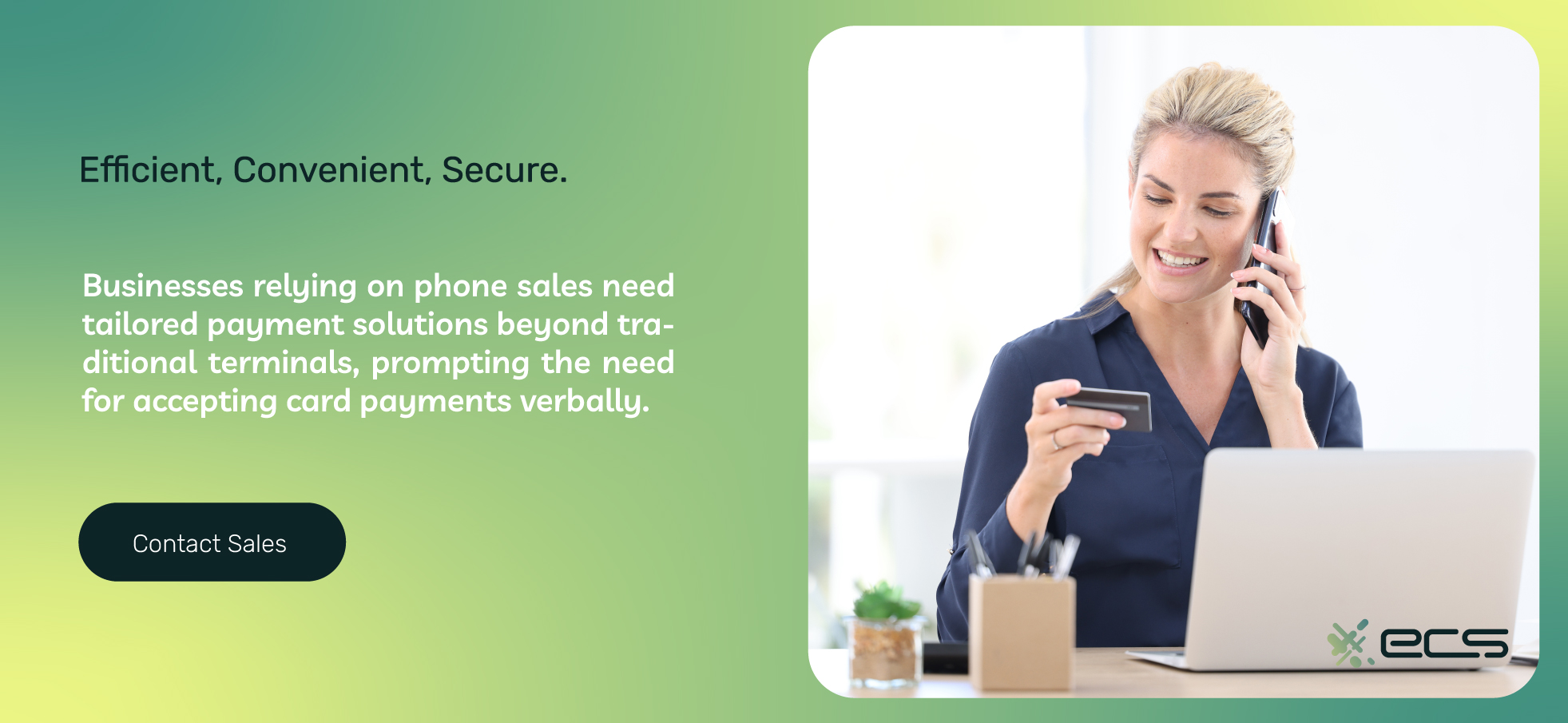
Sales-Powered Orgs: MOTO is Your MOJO
MOTO stands for “mail order/telephone order.” It’s an acronym for when an employee or business owner manually enters provided card information, rather than physically taking a credit card and swiping or dipping it or even accepting mobile payments (e.g., a digital wallet payment).
Did you know that 55% of high-growth companies rely on cold calling as a primary strategy for generating leads? They may have others, like inbound marketing, but calling a complete stranger is still a cornerstone of successful sales.
In B2B conversations, these calls often lead to a demo. The customer does not pay for anything until the deal is closed. However, in B2C conversations, the sale can happen on that initial call. You need to be ready to collect payment information smoothly then and there.
MOTO payments are the lifeblood of sales-powered organizations. Many consultants (B2C ones like personal trainers or coaches, for example) have a content sales funnel that leads to a phone call.
They offer free content on Instagram, encourage followers to attend webinars, and then guide them to call in for a personal consultation. That phone call is where the pitch is made for additional one-on-one coaching. Do you have a credit card ready?
Pharmacies and Medical Offices
There are several reasons why medical offices and healthcare providers will want to accept payments over the phone. At the end of a visit, you may not be entirely sure how much a patient owes due to the complexity of the insurance landscape. You may send your patients bills once this is all ironed out.
Some patients may want to pay online, in which case you will need an online payment gateway. However, some patients may want to call their payment in. They may be confused about making a payment online or not trust it. Or, they may want to accompany their payment with a question—either about the underlying medical issue or the costs associated with care.
For pharmacies, collecting phone payments is a must. Patients may want to call in an order ahead of time and make a quick, anonymous-as-possible pickup. Since you’re selling products instead of services (unlike the doctors prescribing medications), you need to defend your cash flow more seriously. Collecting payment upfront is one way to do that.
Service Providers
Service providers should also take payments over the phone. By taking bookings and collecting payment right over the phone, you can kill two birds with one stone. You may not want to charge the customer upfront for your services (and they won’t like that either), but you can preauthorize a charge by collecting payment information before a visit.
Allowing customers to call the office and make a payment also makes it easier to collect payments. Ideally, you want to teach all your contractors how to take mobile payments on their phone or mobile card terminals. However, you should still leave the option open for some customers to call in and pay for their services.
Hotels And Restaurants
Hospitality is probably the economic sector that most obviously needs phone payments. Travelers want to book hotels and pay for them ahead of time. Even if you don’t require payment until check-in, you still want to present that option. Restaurants sending out delivery orders will never see the customer; they need to collect payments remotely.
It’s a great idea to have your own app (for takeout) or work with a third party to collect orders or bookings. However, you still want to keep your own direct sales channels open. For starters, these apps charge astronomical fees. DoorDash, for instance, can charge 25%.
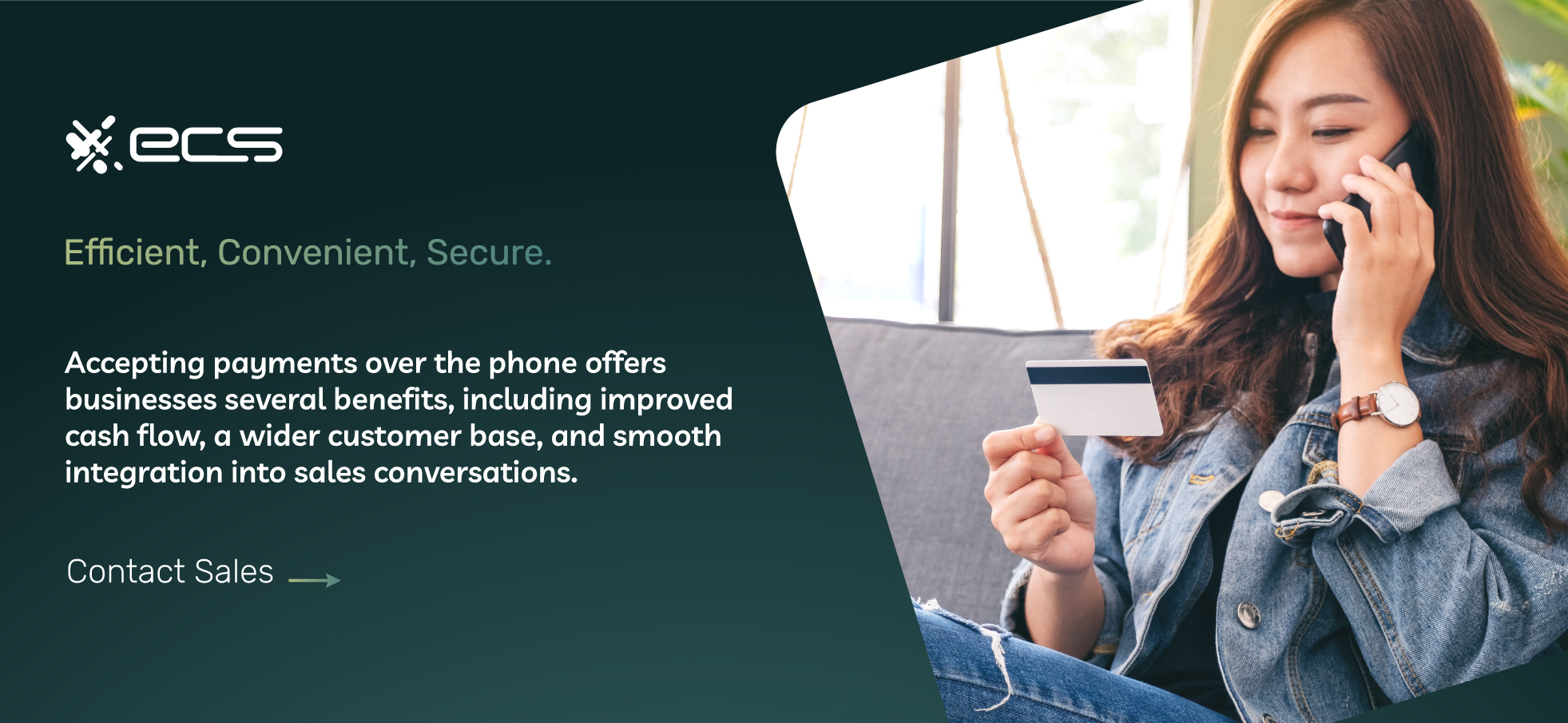
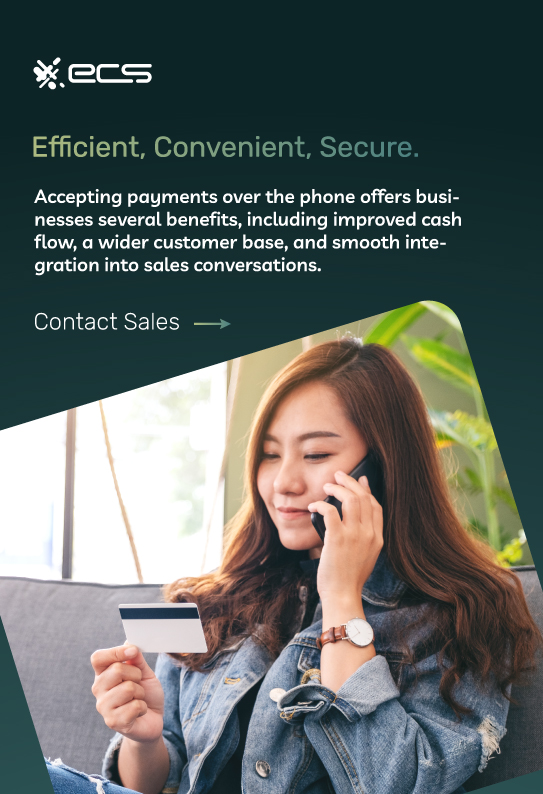
Benefits Of Accepting Payments Over The Phone
Improved Cash Flow
Capture more payments up front when customers sign up for your services. On the churn-reduction end of things, salvage calls can become opportunities for new purchases. You didn’t enjoy this product? Let’s get you into a different one. We’ll refund your original purchase. Let me tell you about something that might be a better fit…
Wider Customer Base
Taking payments over the phone creates the same opportunity afforded by eCommerce. That is, you broaden the reach of your business far beyond the walls of your brick-and-mortar. In fact, if MOTO payments are part of a cold-calling model, your proactive reach may go even further than inbound, paid-search, and SEO-driven eCommerce.
Convenience And Flexibility
Customers can make a payment from anywhere they get phone service, which is most places. They don’t need to visit your store in person, go online, or even have Wi-Fi. They just need a credit or debit card and a working phone.
Smooth Integration Into Sales Conversations
Collecting online payments makes closing deals much more straightforward. When you tell a customer to go to your website after the call or even to click on a link that you’ll send them, you may end up losing some customers. They’ll have a moment to rethink their decision. By contrast, if you can collect card information during a conversation, you’ll have a much higher win rate.
Risks Of Accepting Payments Over The Phone
Manual Errors
Inputting card numbers means risking manual data entry errors. Some studies have shown that manual data entry can yield error rates as high as 40% (this astronomical number is the upper end of rates). Obviously, automated POS terminals or online payment gateways eliminate a number of these manual errors.
Increased Risk Of Fraud
Another risk of phone payments is fraud. Because you don’t see the person in front of you, you can’t gauge if there is something suspicious about the transaction, let alone look at the card.
Thankfully, within the last several years, financial institutions have developed AI and machine-learning tools that can prevent some fraud.
For example, they can compare a transaction to a list of typical transactions that a particular cardholder might make and see if it fits within those parameters.
Regulatory Requirements
Collecting card information over the phone may trigger some regulatory requirements, both nationally and in your state. Universal requirements are set forth by the PCI DSS standards promulgated by card networks.
Payment Card Industry Data Security Standards are rules that prevent actions like scribbling down card numbers and leaving them where they can be seen. Some states also have stricter rules about collecting MOTO payments.
Higher Fees For CNP Transactions
Because of the higher potential for fraud, MOTO payments will have higher payment processing fees. These fees offset the risk for the payment processor of dealing with chargebacks (chargebacks are disputes filed by cardholders).
As mentioned, the cardholder is not in front of you with a phone payment. Therefore, like internet payments, they are classified as Card-Not-Present or CNP transactions, which have higher fees.
How Much Does It Cost To Accept Payments Over The Phone?
This question can only be answered by your payment processor. However, as discussed, MOTO payments are CNP payments, so their fees will be higher than those for in-person payments.
For example, payment aggregator Stripe charges nearly 3% + $0.30 for CNP transactions and 2.7% + $0.05 for in-person transactions. That’s a whopping 600% increase for the fixed charge and a hefty 11% increase for the percentage.
One factor that could mitigate the damage of CNP transactions is the overall setup of your fees. Flat rate pricing is acceptable for low-volume businesses that are just starting out. But they are punitive for businesses that have an average sales volume.
The cost of taking credit and debit cards differs, as does the cost of accepting Visa versus Mastercard versus Amex versus Discover. A Visa debit card, for instance, will usually cost you much less to process than an Amex credit card.
CNP pricing that does not consider these nuances will end up costing you more. What you want to find is called “interchange plus pricing.” With interchange plus, even if CNP transactions cost you more than in-person transactions, at least you won’t be paying the same (bad) price for every single MOTO payment.
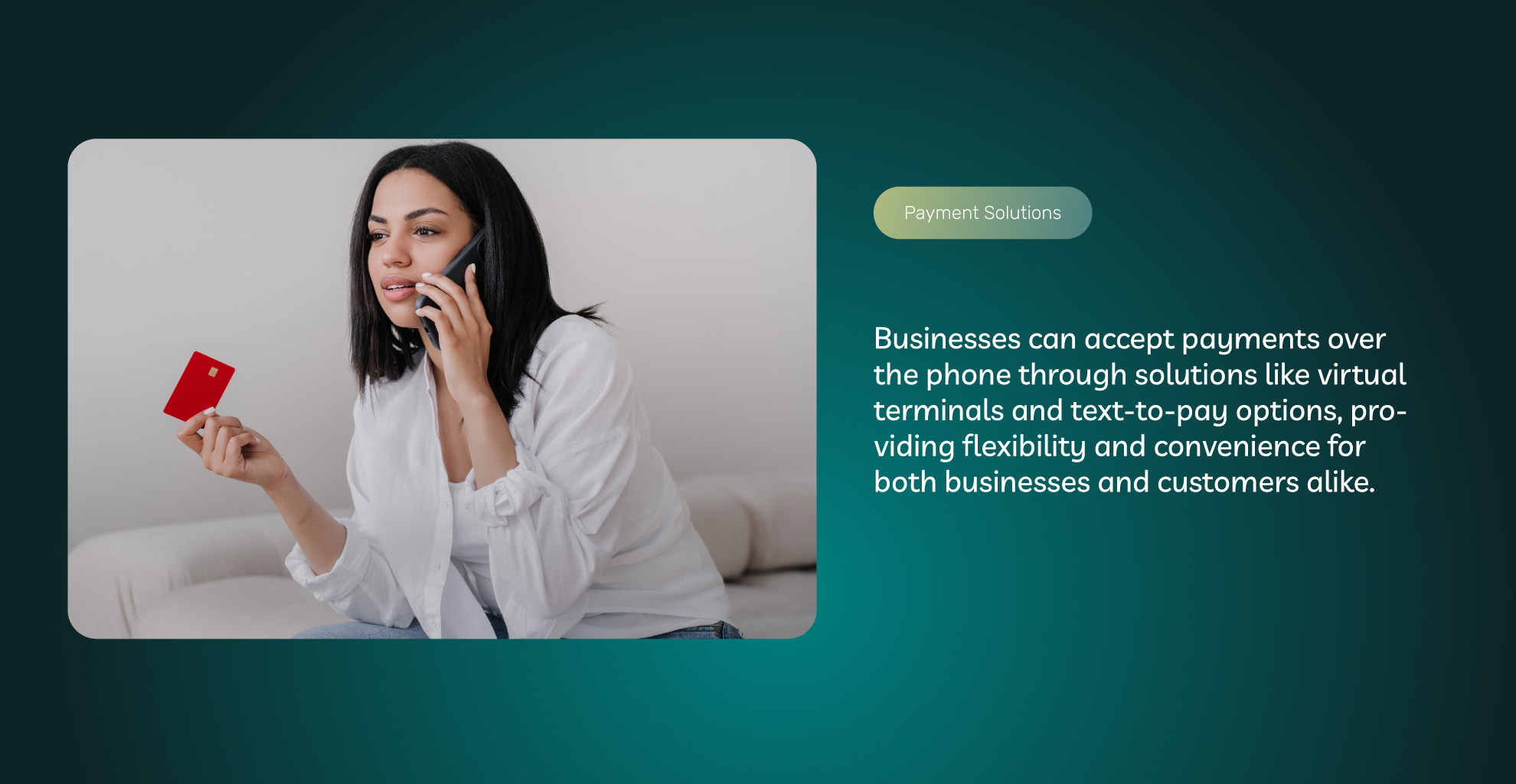
How To Accept Payments From Customers Over The Phone
Virtual Terminal
You’re not going to be taking any actual credit cards. And while some POS systems allow you to manually input data, you don’t need to pay for a POS if you’re never (or rarely) going to be collecting cards. What you need is a virtual terminal.
A virtual terminal these days is (more likely than not) going to be a cloud-based subscription service you can access from anywhere. It is almost like the payment gateway a customer would see when inputting their card info.
However, it is only for you to see, and you’ll be inputting all the cardholder data (number, expiration date, CVV, and possibly other info like zip code).
Your payment processor can provide you with a virtual terminal. They can also provide security measures around said terminals, such as firewalls, proxy piercing, encryption, and proper storage of cardholder data (if you’re setting up recurring charges).
Text-To-Pay
But as we alluded to at the outset of this article, accepting payments over the phone doesn’t mean you have to do them yourself. Recall that manual data entry can result in errors. What if you could just get the customer to pay themselves and automate the exchange of information to eliminate the possibility of error?
That’s where text-to-pay and mobile credit card payments come into play. You can ask to send the customer a payment link right to their mobile device. They can click on this link and be directed to a payment page.
If they have to input the card data themselves, this won’t eliminate the risk of data entry, and it won’t eliminate the higher CNP fees. However, if they have a mobile wallet like ApplePay or GooglePay, the payment process can be streamlined to just a few finger taps.
Whether you are using text-to-pay or inputting data yourself into a virtual terminal, you want the transaction to be synched up to your accounting software and inventory software. You also want it to automatically generate email or text receipts for the customer (possibly paper invoices as well, to be mailed).
These connections are called integrations. Your payment processor may be able to ensure that their payment gateway is integrated with accounting, inventory, and even CRM software. Just ask about the integrations they can provide with their virtual terminals for MOTO payments.
So…Is It Possible To Accept Credit Card Payments Over The Phone?
Yes, it most certainly is. This contactless payment option provides great flexibility for you and your customers. On the other hand, they are regarded as Card Not Present transactions, which means greater fees. However, having a merchant account services provider that offers interchange plus pricing can mitigate the fee-related damage.
Ready to implement over-the-phone solutions in your business? Contact ECS Payments for more information. Our knowledgeable team is ready to assist you!
Frequently Asked Questions for Accepting Payments Over the Phone
Businesses such as hotels, restaurants, service providers, medical offices, and sales-powered organizations often need to accept payments over the phone. Whether for booking services, takeout or delivery, ordering products, or closing sales, these businesses benefit from the flexibility that phone payments offer.
Accepting payments over the phone provides convenience and flexibility for customers, widens the customer base by extending payment options and reach beyond physical locations, improves cash flow by capturing payments upfront, and integrates smoothly into sales conversations to help increase the conversion rate.
Risks of over-the-phone payments include manual errors when inputting card numbers, increased susceptibility to fraud due to the lack of a physical card, and higher fees for Card-Not-Present (CNP) transactions.
The cost varies depending on the payment processor rates and the card type. Generally, phone payments incur higher fees than in-person transactions because the card is not present, increasing the risk of fraud. However, payment processors may offer different pricing models, such as flat-rate pricing, which would mean phone and in-person payments would cost the same but could make the overall cost of processing payments expensive, or interchange plus pricing, which considers the nuances of card types and transaction volumes and could potentially reduce costs.
